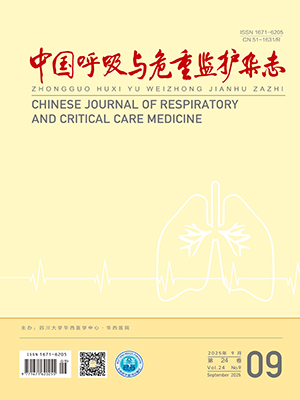| 1. |
Riley CM, Sciurba FC. Diagnosis and outpatient management of chronic obstructive pulmonary disease: a review. JAMA, 2019, 321(8): 786-797.
|
| 2. |
Wang C, Xu JY, Yang L, et al. Prevalence and risk factors of chronic obstructive pulmonary disease in China (the China Pulmonary Health study): a national cross-sectional study. Lancet, 2018, 391(10131): 1706-1717.
|
| 3. |
Man WD, Soliman MG, Nikoletou D, et al. Non-volitional assessment of skeletal muscle strength in patients with chronic obstructive pulmonary disease. Thorax, 2003, 58(8): 665-669.
|
| 4. |
Seymour JM, Spruit MA, Hopkinson NS, et al. The prevalence of quadriceps weakness in COPD and the relationship with disease severity. Eur Respir J, 2010, 36(1): 81-88.
|
| 5. |
Kharbanda S, Ramakrishna A, Krishnan S. Prevalence of quadriceps muscle weakness in patients with COPD and its association with disease severity. Int J Chron Obstruct Pulmon Dis, 2015, 10(1): 1727-1735.
|
| 6. |
Decramer M, Gosselink R, Troosters T, et al. Muscle weakness is related to utilization of health care resources in COPD patients. Eur Respir J, 1997, 10(2): 417-423.
|
| 7. |
Jaitovich A, Barreiro E. Skeletal muscle dysfunction in chronic obstructive pulmonary disease: what we know and can do for our patients. Am J Respir Crit Care Med, 2018, 15(2): 175-186.
|
| 8. |
Creze M, Nordez A, Soubeyrand M, et al. Shear wave sonoelastography of skeletal muscle: basic principles, biomechanical concepts, clinical applications, and future perspectives. Skeletal Radiol, 2018, 47(4): 457-471.
|
| 9. |
Sigrist RMS, Liau J, Kaffas AE, et al. Ultrasound elastography: review of techniques and clinical applications. Theranostics, 2017, 7(5): 1303-1329.
|
| 10. |
张丽, 王虹, 万毅新. 支气管内超声实时弹性成像技术的应用及研究进展. 中国呼吸与危重监护杂志, 2017, 7(5): 1303-1329.
|
| 11. |
Taljanovic MS, Gimber LH, Becker GW, et al. Shear-wave elastography: basic physics and musculoskeletal applications. Radiographics, 2017, 37(3): 855-870.
|
| 12. |
Xu JH, Wu ZZ, Tao FY, et al. Ultrasound shear wave elastography for evaluation of diaphragm stiffness in patients with stable COPD: a pilot trial. J Ultrasound Med, 2021, 40(12): 2655-2663.
|
| 13. |
Labaki WW, Rosenberg SR. Chronic obstructive pulmonary disease. Ann Intern Med, 2020, 173(3): ITC17-ITC32.
|
| 14. |
Chino K, Kawakami Y, Takahashi H. Tissue elasticity of in vivo skeletal muscles measured in the transverse and longitudinal planes using shear wave elastography. Clin Physiol Funct Imaging, 2017, 37(4): 394-399.
|
| 15. |
Cortez CD, Hermitte L, Ramain A, et al. Ultrasound shear wave velocity in skeletal muscle: a reproducibility study. Diagn Interv Imaging, 2016, 97(1): 71-79.
|
| 16. |
Zhou QT, Mei JJ, He B, et al. Chronic obstructive pulmonary disease assessment test score correlated with dyspnea score in a large sample of Chinese patients. Chin Med J (Engl), 2013, 126(1): 11-15.
|
| 17. |
Cui LW, Ji XL, Xie MS, et al. Role of inspiratory capacity on dyspnea evaluation in COPD with or without emphysematous lesions: a pilot study. Int J Chron Obstruct Pulmon Dis, 2017, 12: 2823-2830.
|
| 18. |
ATS Committee on Proficiency Standards for Clinical Pulmonary Function Laboratories. ATS Statement: Guidelines for the Six-Minute Walk Test. Am J Respir Crit Care Med, 2002, 166(1): 111-117. Erratum in: Am J Respir Crit Care Med, 2016, 193(10): 1185.
|
| 19. |
Shrout PE, Fleiss JL. Intraclass correlations: uses in assessing rater reliability. Psychol Bull, 1979, 86(2): 420-428.
|
| 20. |
Lacourpaille L, Hug F, Bouillard K, et al. Supersonic shear imaging provides a reliable measurement of resting muscle shear elastic modulus. Physiol Meas, 2012, 33(3): 19-28.
|
| 21. |
Taş S, Onur MR, Yilmaz S, et al. Shear wave elastography is a reliable and repeatable method for measuring the elastic modulus of the rectus femoris muscle and patellar tendon. J Ultrasound Med, 2017, 36(3): 565-570.
|
| 22. |
Donaldson AV, Maddocks M, Martolini D, et al. Muscle function in COPD: a complex interplay. Int J Chron Obstruct Pulmon Dis, 2012, 7: 523-535.
|
| 23. |
Maynard-Paquette AC, Poirier C, Chartrand-Lefebvre C, et al. Ultrasound evaluation of the quadriceps muscle contractile index in patients with stable chronic obstructive pulmonary disease: relationships with clinical symptoms, disease severity and diaphragm contractility. Int J Chron Obstruct Pulmon Dis, 2020, 15: 79-88.
|
| 24. |
Ruas CV, Brown LE, Lima CD, et al. Different muscle action training protocols on quadriceps-hamstrings neuromuscular adaptations. Int J Sports Med, 2018, 39(5): 355-365.
|




